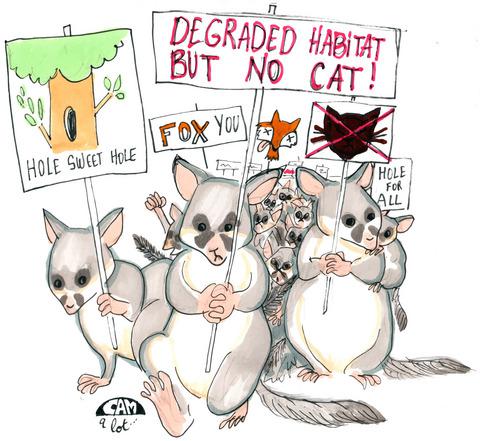当前位置:
X-MOL 学术
›
Austral Ecol.
›
论文详情
Our official English website, www.x-mol.net, welcomes your feedback! (Note: you will need to create a separate account there.)
Can reintroductions to degraded habitat succeed? A test using the common brushtail possum
Austral Ecology ( IF 1.5 ) Pub Date : 2020-03-11 , DOI: 10.1111/aec.12880 Katherine E. Moseby 1, 2 , Robert Brandle 3 , Patrick Hodgens 2 , Hannah L. Bannister 4
Austral Ecology ( IF 1.5 ) Pub Date : 2020-03-11 , DOI: 10.1111/aec.12880 Katherine E. Moseby 1, 2 , Robert Brandle 3 , Patrick Hodgens 2 , Hannah L. Bannister 4
Affiliation

|
Habitat degradation contributes to species decline, and habitat quality is an important factor influencing reintroduction success globally. Habitat quality can include a range of physical resources such as nest sites and food resources but also anything that can restrict the use of these resources such as predation risk or competition. In arid Australia, introduced predators are thought to be the primary cause of mammal extinction and reintroduction failure although habitat clearance and alteration are also major causes of population decline. Common brushtail possums are one arid Australian marsupial close to regional extinction. To understand whether habitat quality was limiting their recovery, we reintroduced 148 possums into an area where introduced red foxes were controlled but historic overgrazing had degraded the habitat. We measured both direct (hollow availability, midstorey cover and high‐quality plant foods) and indirect (survival, condition, reproduction, movement) measures of habitat quality. Sixty‐seven released possums and 26 post‐release recruits were radiocollared for up to 2 years after release. Post‐release survival of radiocollared possums was high after 12 months (0.70), and there were no deaths from starvation. Predation by feral cats was the most common cause of mortality, and the open, degraded habitat may have exacerbated predation risk. Continuous breeding, good body condition and comparative home ranges with other sites suggested that food resources were not limiting. Possums used natural tree hollows in Eucalyptus spp. with no use of artificial nest boxes. Results suggest that historically degraded habitat was not a barrier to short‐term reintroduction success when foxes were controlled and natural tree hollows were plentiful. However, demographic data on hollow‐bearing tree species suggest a possible future decline in availability of hollows. These factors, combined with the unknown effects of drought, and synergistic effects of predation and poor quality habitat, suggest long‐term reintroduction success may require improved habitat and cat control.
中文翻译:

重新引入退化的栖息地能否成功?使用普通无尾负鼠进行测试
栖息地退化导致物种减少,栖息地质量是影响全球重新引进成功的重要因素。栖息地质量可以包括一系列自然资源,例如筑巢地和食物资源,还可以包括任何可能限制这些资源使用的东西,例如掠食风险或竞争。在干旱的澳大利亚,引入的捕食者被认为是哺乳动物灭绝和重新引入失败的主要原因,尽管栖息地的清除和改变也是种群减少的主要原因。常见的无尾负鼠是一种接近区域灭绝的干旱澳大利亚有袋动物。为了了解栖息地的质量是否会限制其恢复,我们将148个负鼠重新引入到控制引进的狐狸但历史上过度放牧使栖息地退化的地区。我们测量了栖息地质量的直接(空心度,中间层覆盖度和优质植物性食品)和间接(生存率,状况,繁殖,移动)度量。释放后67年释放负鼠和26个释放后新兵长达2年。放射性领的负鼠的释放后存活率在12个月后较高(0.70),并且没有因饥饿而死亡。野猫的捕食是造成死亡的最常见原因,开放的,退化的栖息地可能加剧了捕食的风险。连续繁殖,良好的身体状况以及与其他地点的比较家庭范围表明,食物资源不受限制。负鼠用天然树洞 运动)的生境质量度量。在被释放后长达两年的时间里,有67个被释放的负鼠和26个被释放的新兵被进行了无线电领。放射性领的负鼠的释放后存活率在12个月后较高(0.70),并且没有因饥饿而死亡。野猫的捕食是造成死亡的最常见原因,开放的,退化的栖息地可能加剧了捕食的风险。连续繁殖,良好的身体状况以及与其他地点的比较家庭范围表明,食物资源没有限制。负鼠用天然树洞 运动)的生境质量度量。释放后67年释放负鼠和26个释放后新兵长达2年。放射性领的负鼠的释放后存活率在12个月后较高(0.70),并且没有因饥饿而死亡。野猫的捕食是造成死亡的最常见原因,开放的,退化的栖息地可能加剧了捕食的风险。连续繁殖,良好的身体状况以及与其他地点的比较家庭范围表明,食物资源没有限制。负鼠用天然树洞 野猫的捕食是造成死亡的最常见原因,开放,退化的栖息地可能加剧了捕食的风险。连续繁殖,良好的身体状况以及与其他地点的比较家庭范围表明,食物资源不受限制。负鼠用天然树洞 野猫的捕食是造成死亡的最常见原因,开放的,退化的栖息地可能加剧了捕食的风险。连续繁殖,良好的身体状况以及与其他地点的比较家庭范围表明,食物资源没有限制。负鼠用天然树洞桉树属。无需使用人工巢箱。结果表明,当狐狸受到控制且自然树洞很多时,历史退化的栖息地不会成为短期内重新引入成功的障碍。但是,有关空心树种的人口统计数据表明,空心物的可用性将来可能会下降。这些因素,再加上干旱的未知影响,以及掠食和劣质栖息地的协同效应,表明长期成功导入可能需要改善栖息地和猫的控制。
更新日期:2020-03-11
中文翻译:

重新引入退化的栖息地能否成功?使用普通无尾负鼠进行测试
栖息地退化导致物种减少,栖息地质量是影响全球重新引进成功的重要因素。栖息地质量可以包括一系列自然资源,例如筑巢地和食物资源,还可以包括任何可能限制这些资源使用的东西,例如掠食风险或竞争。在干旱的澳大利亚,引入的捕食者被认为是哺乳动物灭绝和重新引入失败的主要原因,尽管栖息地的清除和改变也是种群减少的主要原因。常见的无尾负鼠是一种接近区域灭绝的干旱澳大利亚有袋动物。为了了解栖息地的质量是否会限制其恢复,我们将148个负鼠重新引入到控制引进的狐狸但历史上过度放牧使栖息地退化的地区。我们测量了栖息地质量的直接(空心度,中间层覆盖度和优质植物性食品)和间接(生存率,状况,繁殖,移动)度量。释放后67年释放负鼠和26个释放后新兵长达2年。放射性领的负鼠的释放后存活率在12个月后较高(0.70),并且没有因饥饿而死亡。野猫的捕食是造成死亡的最常见原因,开放的,退化的栖息地可能加剧了捕食的风险。连续繁殖,良好的身体状况以及与其他地点的比较家庭范围表明,食物资源不受限制。负鼠用天然树洞 运动)的生境质量度量。在被释放后长达两年的时间里,有67个被释放的负鼠和26个被释放的新兵被进行了无线电领。放射性领的负鼠的释放后存活率在12个月后较高(0.70),并且没有因饥饿而死亡。野猫的捕食是造成死亡的最常见原因,开放的,退化的栖息地可能加剧了捕食的风险。连续繁殖,良好的身体状况以及与其他地点的比较家庭范围表明,食物资源没有限制。负鼠用天然树洞 运动)的生境质量度量。释放后67年释放负鼠和26个释放后新兵长达2年。放射性领的负鼠的释放后存活率在12个月后较高(0.70),并且没有因饥饿而死亡。野猫的捕食是造成死亡的最常见原因,开放的,退化的栖息地可能加剧了捕食的风险。连续繁殖,良好的身体状况以及与其他地点的比较家庭范围表明,食物资源没有限制。负鼠用天然树洞 野猫的捕食是造成死亡的最常见原因,开放,退化的栖息地可能加剧了捕食的风险。连续繁殖,良好的身体状况以及与其他地点的比较家庭范围表明,食物资源不受限制。负鼠用天然树洞 野猫的捕食是造成死亡的最常见原因,开放的,退化的栖息地可能加剧了捕食的风险。连续繁殖,良好的身体状况以及与其他地点的比较家庭范围表明,食物资源没有限制。负鼠用天然树洞桉树属。无需使用人工巢箱。结果表明,当狐狸受到控制且自然树洞很多时,历史退化的栖息地不会成为短期内重新引入成功的障碍。但是,有关空心树种的人口统计数据表明,空心物的可用性将来可能会下降。这些因素,再加上干旱的未知影响,以及掠食和劣质栖息地的协同效应,表明长期成功导入可能需要改善栖息地和猫的控制。



























 京公网安备 11010802027423号
京公网安备 11010802027423号